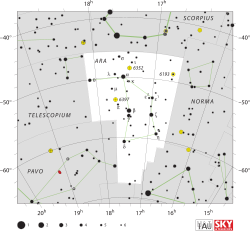(Redirected from Epsilon² Arae )
Star in the constellation Ara
For other star systems with this Bayer designation , see Epsilon Arae .
Epsilon Arae (ε Arae, ε Ara) is the Bayer designation for a double star in the southern constellation of Ara . It is approximately 89 light-years (27 parsecs ) distant from Earth . With an apparent visual magnitude of 5.3, it is faintly visible to the naked eye.
The brighter star is a magnitude 5.44 F-type main sequence star with a stellar classification of F5 V Fe+0.5. The Fe+0.5 notation indicates that it has a somewhat higher than normal abundance of iron. It has a magnitude 8.65 companion at an angular separation of 0.590 arcseconds . It has a common proper motion white dwarf companion, WDS J17031-5314, with a magnitude of 13.47.
References
^ van Leeuwen, F. (November 2007), "Validation of the new Hipparcos reduction", Astronomy and Astrophysics , 474 (2): 653–664, arXiv :0708.1752 , Bibcode :2007A&A...474..653V , doi :10.1051/0004-6361:20078357 , S2CID 18759600 .
^ Corben, P. M.; Stoy, R. H. (1968), "Photoelectric Magnitudes and Colours for Bright Southern Stars", Monthly Notes of the Astronomical Society of Southern Africa , 27 : 11, Bibcode :1968MNSSA..27...11C .
^ Eggleton, P. P.; Tokovinin, A. A. (September 2008), "A catalogue of multiplicity among bright stellar systems", Monthly Notices of the Royal Astronomical Society 389 (2): 869–879, arXiv :0806.2878 , Bibcode :2008MNRAS.389..869E , doi :10.1111/j.1365-2966.2008.13596.x , S2CID 14878976 .
^ Gray, R. O.; et al. (July 2006), "Contributions to the Nearby Stars (NStars) Project: Spectroscopy of Stars Earlier than M0 within 40 parsecs: The Northern Sample I", The Astronomical Journal , 132 (1): 161–170, arXiv :astro-ph/0603770 , Bibcode :2006AJ....132..161G , doi :10.1086/504637 , S2CID 119476992 .
^ "* eps02 Ara" . SIMBAD Centre de données astronomiques de Strasbourg . Retrieved 2015-03-03.
^ Holmberg, J.; Nordström, B.; Andersen, J. (July 2009), "The Geneva-Copenhagen survey of the solar neighbourhood. III. Improved distances, ages, and kinematics", Astronomy and Astrophysics Supplement Series , 501 (3): 941–947, arXiv :0811.3982 , Bibcode :2009A&A...501..941H , doi :10.1051/0004-6361/200811191 , S2CID 118577511 .
^ Balachandran, Suchitra (May 1, 1990), "Lithium depletion and rotation in main-sequence stars", Astrophysical Journal, Part 1 , 354 : 310–332, Bibcode :1990ApJ...354..310B , doi :10.1086/168691 .
Schröder, C.; Reiners, Ansgar; Schmitt, Jürgen H. M. M. (January 2009), "Ca II HK emission in rapidly rotating stars. Evidence for an onset of the solar-type dynamo" (PDF), Astronomy and Astrophysics , 493 (3): 1099–1107, Bibcode :2009A&A...493.1099S , doi :10.1051/0004-6361:200810377
"GJ 2125 -- White Dwarf" , SIMBAD Astronomical Database , Centre de Données astronomiques de Strasbourg , retrieved 2010-07-28.
External links
Categories :
Epsilon Arae
Add topic
Text is available under the Creative Commons Attribution-ShareAlike License. Additional terms may apply.
**DISCLAIMER** We are not affiliated with Wikipedia, and Cloudflare.
The information presented on this site is for general informational purposes only and does not constitute medical advice.
You should always have a personal consultation with a healthcare professional before making changes to your diet, medication, or exercise routine.
AI helps with the correspondence in our chat.
We participate in an affiliate program. If you buy something through a link, we may earn a commission 💕
↑
